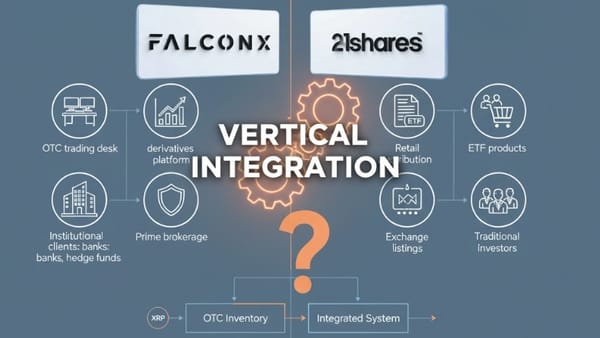Fed Ends Special Crypto Bank Oversight Program After Two Years
The Federal Reserve ends its special crypto oversight program after two years, integrating digital asset supervision into standard banking frameworks. This regulatory shift could accelerate institutional adoption and benefit XRP's growth prospects. Read the full analysis.

The Federal Reserve announced Friday it is shuttering its Novel Activities Supervision Program, marking a significant shift toward integrating crypto oversight into standard banking supervision. The program, launched in 2023, was initially designed to focus on how banks interact with emerging technologies, but the central bank now says it has enhanced its understanding of these risks and banks' risk management practices.
What Was the Novel Activities Program?
The Novel Activities Supervision Program enhanced the supervision of novel activities conducted by banking organizations supervised by the Federal Reserve, focusing on crypto-assets, distributed ledger technology (DLT), and complex, technology-driven partnerships with nonbanks to deliver financial services to customers. The program was designed to address activities that existing supervisory frameworks might not adequately cover.
The Novel Activities Supervision Program would have covered a range of activities, including stablecoin issuance, tokenized securities, API-driven partnerships with nonbanks, and banking exposure to crypto clients. The initiative came in the wake of the 2023 banking crisis that saw the collapse of crypto-friendly institutions like Silicon Valley Bank, Silvergate Bank, and Signature Bank.
Regulatory Shift Under New Administration
Since the start of President Donald Trump's second term, the Fed has tended to move in step with the other banking regulators who've pulled back on aggressive digital assets scrutiny. This latest move follows the Fed's April decision to withdraw crypto guidance that required banks to seek regulatory approval before engaging in crypto activities.
The other two U.S. federal banking regulators, the Office of the Comptroller of the Currency and the Federal Deposit Insurance Corp. made matching moves to toss out the previous guidance, leaving banks to make their own crypto decisions under existing risk-management expectations.
Market Implications
The Fed's decision signals growing confidence in the banking sector's ability to manage crypto-related risks within existing frameworks. This aligns with broader regulatory trends, as the FDIC and the Fed previously withdrew advisory statements on banking organizations' engagement with crypto assets earlier in 2025, suggesting coordinated oversight consolidation across federal banking regulators.
Financial institutions can now operate crypto services under standard regulatory expectations rather than specialized oversight procedures. This could reduce compliance costs and regulatory uncertainty for banks considering crypto operations, potentially encouraging broader institutional adoption of digital asset services.
XRP and Ripple: Strategic Positioning for Growth
This regulatory development comes at a pivotal time for Ripple and XRP, which have been positioning themselves for mainstream financial adoption. Ripple has applied for a national banking license from the Office of the Comptroller of the Currency, aiming to expand its crypto services under federal regulation. The company also applied for a Federal Reserve master account via its subsidiary Standard Custody, which would provide direct access to Fed payment rails.
XRP Price Potential
The Fed's more accommodating stance toward crypto banking could benefit XRP's price trajectory. XRP recently shot up to $3.01, adding more than 7% in a single day, and regulatory clarity has historically been a positive catalyst for the token. Over the past year, XRP has surged nearly 390%, with a strong rally in July 2025 that brought it close to its 2018 all-time high of $3.84.
Market analysts suggest that reduced regulatory friction could help XRP maintain momentum. CryptoRank's expectations for Ripple put XRP in the $3.2-$4 range, with an average price around $3.4, contingent on continued institutional interest and regulatory developments.
Ripple's Business Operations
The streamlined oversight approach could accelerate Ripple's institutional partnerships. Ripple launched RLUSD in December 2024, and while still small compared to market leaders like Tether and Circle's USD Coin, RLUSD has grown to a market value of around $470 million.
With banks no longer requiring special approval for crypto activities, financial institutions may be more willing to integrate Ripple's payment solutions and stablecoin offerings into their operations.
Legal Standing and Partnership Opportunities
The July 2023 court ruling—which classified XRP as non-secular—position it as a potentially significant player in the evolving digital financial ecosystem. The Fed's decision to normalize crypto oversight removes another potential barrier to institutional adoption.
Ripple's pursuit of federal banking charter and master account access, combined with reduced regulatory scrutiny, creates a clearer path for partnership expansion with traditional financial institutions.
Adoption Prospects
Ripple CTO David Schwartz underscored the XRP Ledger's readiness to serve as a backbone for global finance, noting that more payments and stablecoin companies are launching their own blockchains. He explained that XRPL's trust, liquidity, and developer base set it apart from newer chains.
The Fed's regulatory shift aligns with Schwartz's assertion that XRPL is public and permissionless, but also supports optional permissioned features for regulated use, making it adaptable to traditional banking requirements.
Looking Forward
The Federal Reserve said it will wind down a Biden-era initiative that was designed to step up scrutiny of lenders' involvement in digital assets, building on recent moves from US regulators to embrace the crypto industry. This represents a fundamental shift from restrictive oversight to integration within existing frameworks.
For the crypto industry, this development signals maturation and acceptance within traditional financial supervision. Banks can now evaluate crypto opportunities using standard risk management practices rather than navigating specialized regulatory hurdles.
The consolidation of crypto oversight into routine supervision suggests regulators view digital assets as sufficiently understood and manageable within existing banking frameworks—a milestone that could accelerate institutional adoption and mainstream integration.
Sources
- Reuters - Fed to Scrap Program Devoted to Policing Banks on Crypto, Fintech Activities
- CoinDesk - U.S. Fed Officially Scraps Specialist Group Meant to Oversee Crypto Issues
- Bloomberg - Fed to End Program That Stepped Up Bank-Crypto Scrutiny
- Federal Reserve Board - Novel Activities Supervision Program
- Federal Reserve Board - SR 23-7: Creation of Novel Activities Supervision Program
- Crypto Briefing - Fed ends its novel activities program
- Bitcoin Ethereum News - Fed scraps oversight program for banks' crypto, fintech activities
- Cybernews - US Fed says it will scrap crypto and fintech banking oversight program
DISCLAIMER: This newsletter is for informational purposes only and does not constitute investment advice or a recommendation to buy, sell, or hold any securities. Investments in cryptocurrencies or other financial assets carry significant risks, including the potential for total loss, extreme volatility, and regulatory uncertainty. Past performance is not indicative of future results. Always consult a qualified financial professional and conduct thorough research before making any investment decisions.



